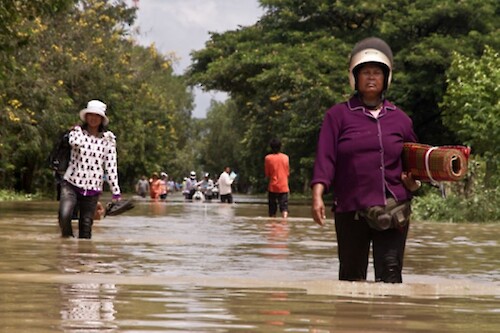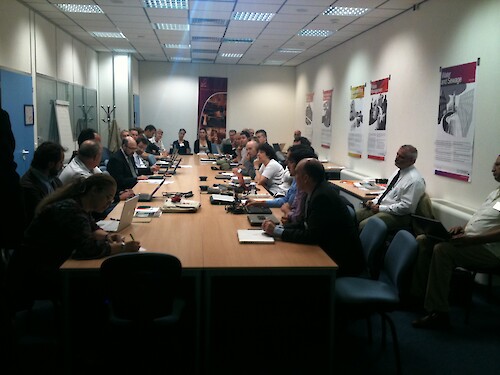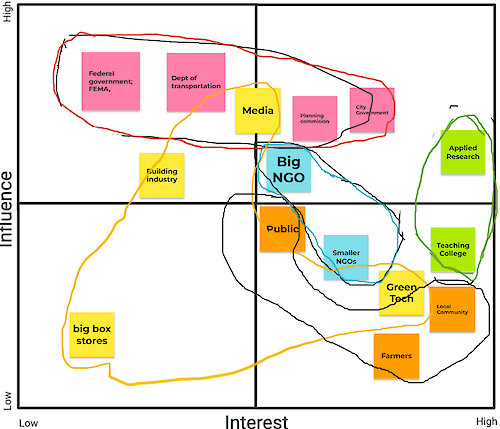Addressing the Socio-Environmental Problems of Today to Attain a Sustainable Tomorrow
Joy Amadi ·It is impossible to consider human survival on Earth without taking environmental resources into account.3 In the past, the industrial revolution caused a division between human development and nature. Nonetheless, socio-environmental issues have contributed to the depletion of natural resources, particularly in recent decades. There is a conflict between our development approaches and the need to safeguard life.5 Population growth, consumption and production patterns have depleted the planet’s non-renewable resources. To ensure a possible tomorrow, it is paramount that we reflect on the future of the planet and its inhabitants.

One issue that emphasizes the urgency of socio-environmental issues is climate change.1 A change in climate will lead to changes that can impact all environmental systems on the planet.2 Human activities such as the burning of fossil fuels increases greenhouse gas emissions, causing climate change and global warming. Sea levels rising, high frequency of extreme weather events, and shifting weather seasons, are some of the consequences of human induced climate change. This puts the global economy and public health in jeopardy.4 While climate change affects the entire planet, it's crucial to understand that impoverished and marginalized populations are more affected than others. Extreme weather patterns bring high rainfall, which in turn causes floods. Flooding has increased for those who live in poor communities, especially near the ocean. To ensure that everyone is treated fairly in light of these issues, environmental justice is essential.


The complexity of socio-environmental concerns calls for a holistic approach that recognizes how these issues are connected. One valuable tool for resolving these problems is collaborative learning. Here, active participation of a variety of stakeholders with different viewpoints is encouraged. Stakeholders get the opportunity to learn, share knowledge, and create a common goal for the environment. Under this approach, decision-making and problem-solving are made accessible to communities and individuals. These people must be included, especially those who are disproportionately impacted by the devastating circumstances. This guarantees their equal rights in the decision-making process and empowers them to voice out their worries and experiences and share their understanding of the problem.

The importance of stakeholders management cannot be overemphasized. Even though collaborative learning is a useful tool for addressing complex issues, the identification and prioritization of stakeholders who should be involved in the process has a significant impact on the design of communication and engagement strategies. One way of achieving this is through stakeholder mapping.
During the Science for Environmental Management class, we discussed increased flooding and climate variability and their current impact, challenges, and successful outcomes. We delved into identifying what groups of stakeholders are required to collaborate to solve these problems. We used the stakeholder mapping exercise. This mapping has two dimensions: the level of influence and the level of interest. Stakeholders who should participate in the problem-solving were identified and then placed into a quadrant of low to high influence and low to high interest. Embarking on this exercise gave us insights into who should be managed closely, who should be monitored, who should be kept informed, and who should be kept satisfied. Thus, utilizing stakeholder mapping gives one the ability to manage stakeholders effectively, ensuring that resources such as time and funding are properly allocated and that key stakeholders get the desired attention and engagement needed to be able to contribute significantly to the creation of novel solutions that deal with socio-environmental problems.

Solving socio-environmental issues requires a collaborative effort to achieve that revolutionary shift we all desire. Little actions like leaving our taps running for long and our surroundings being littered, all contribute to current global issues such as the climate crisis. Recognizing how socio-environmental issues are intertwined and the fact that the things we do in one place often have an impact on other places, is crucial. Therefore, let's embrace a sustainable future with all hands on deck. Wondering how that positive change will come about? It begins with you and I.

References
1. Dalhog, Ma. I. (2023). A shift in values is needed to address climate change impacts affecting communities and the environment in the Philippines. Davao Research Journal, 14(2), 80–83. https://doi.org/10.59120/drj.v14i2.131
2. Ventura, A. C., & Davel, E. P. B. (2021). Socio-environmental Impact of Research. Organizações&Sociedade,28(99), 710–721. https://doi.org/10.1590/1984-92302021v28n9900en
3. Abbass, K., Qasim, M. Z., Song, H., Murshed, M., Mahmood, H., & Younis, I. (2022). A review of the global climate change impacts, adaptation, and sustainable mitigation measures. In Environmental Science and Pollution Research (Vol. 29, Issue 28, pp. 42539–42559). Springer Science and Business Media Deutschland GmbH. https://doi.org/10.1007/s11356-022-19718-6
4. Abdullahi, M. L., Jidda-Fada, S., Binbol, N. L., & Nuhu, H. (2023). PUBLIC PERCEPTION OF CLIMATE CHANGE IMPACT ON HEALTH AND ENVIRONMENT IN TARABA STATE, NIGERIA. https://www.researchgate.net/publication/376477687
5. Ulises, R.-S. H., Lucia, F.-M. A., Alejandro, C.-T. C., & Torre-Villaseñor, D. la. (2023). Climate Change and Its Impact on Human Health in Mexico. International Journal of Environment and Climate Change, 13(6), 219–243. https://doi.org/10.9734/ijecc/2023/v13i61819
About the author
Joy Amadi

Joy is a Ph.D. student in the Marine, Estuarine, and Environmental Science program, at the Chesapeake Biological Laboratory, University of Maryland Center for Environmental Science. She works as a graduate research assistant under the supervision of Dr. Michael Gonsior. Her research interest is centered on understanding environmental pollutants, their effects on human health, aquatic life, the earth's atmosphere, and also developing novel methods. Joy is currently researching the Photochemical Fate of Organic UV filters in Natural Waters.
Next Post > CERF Conference in Portland Oregon
Comments
-
Colin Vissering 2 years ago
Hi Joy - really enjoyed how you tied the criticality of the world's climate crisis with some of the detailed collaborative approaches we covered in class. It is unfortunate that it often takes a crisis for people to be more willing and flexible to address problem solving in new and more effective ways.
-
Antonia Zais 2 years ago
The disproportionate affect of climate change on disadvantaged communities is one of the major reasons action is slow in socio-environmental problem solving. Many of the leaders and decision-makers are not feeling the effects of climate change as directly, making it seem like an "overhyped" issue. This is why stakeholder engagement is so important in the modern era. Collaboration between affected communities, scientists, NGOs, elected officials, and more is the key to recognizing the true effects of climate change and to building successful, sustainable solutions.
-
Meghna Mathews 2 years ago
Great blog, Joy! I'm glad you brought up marginalized and impoverished communities often face the effects of climate change more than others. That's not to say others don't experience the consequences, which is important to note. Stakeholder engagement is critical, especially today, because it can provide further justifications for policy change. I agree with Toni's comment that the disproportionate effects of climate change on disadvantaged communities is a major reason in problem solving. Someone that doesn't face the same effects may think "what does that have to do with me?" This is part of the problem, though. Being more willing to address problems that effect others is a step in the right direction.
-
Kayla 2 years ago
Another interesting thing about stakeholder mapping, that we stumbled on in class, is that mapping can be very granular depending on the scale of your project/problem and your knowledge and understanding of smaller stakeholders. Excellent job!
-
Ben Komolafe 2 years ago
I really like the catchy topic of this blog as it is easily reminding me of the United Nations Brundtland Commission definition of sustainability – “meeting the needs of the present without compromising the ability of future generations to meet their own need”.
I fully agree with the message here, the many complex socio-environmental problems in our modern world are mostly human-induced problems and so, to solve them humans must be lead the process and we must find a way to bring all these diverse groups (stakeholders) think up solutions collaboratively.
-
Gage Jacobs 2 years ago
Excellent blog post. I think it tied together everything that we've discussed for most of the class into the main topic of last week very well.
-
Samantha 2 years ago
Great blog I thought the title was what everyone should be thinking about. Climate change is a rough subject because you have your nonbelievers and most of the older generation probably don't care what happens in the future. As scientist we see the change happening quicker then most and conveying that to the public is key. Collaborating with many different organization and graphic representation is the best way to get the message out.

